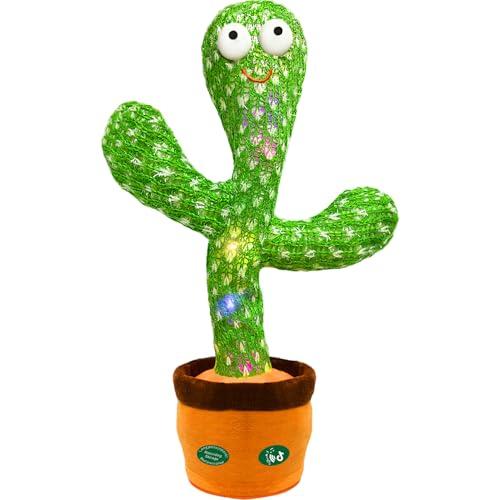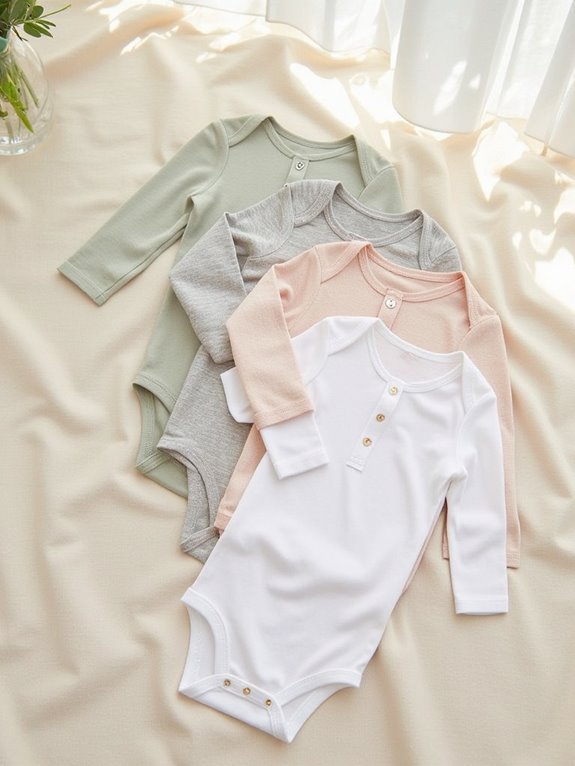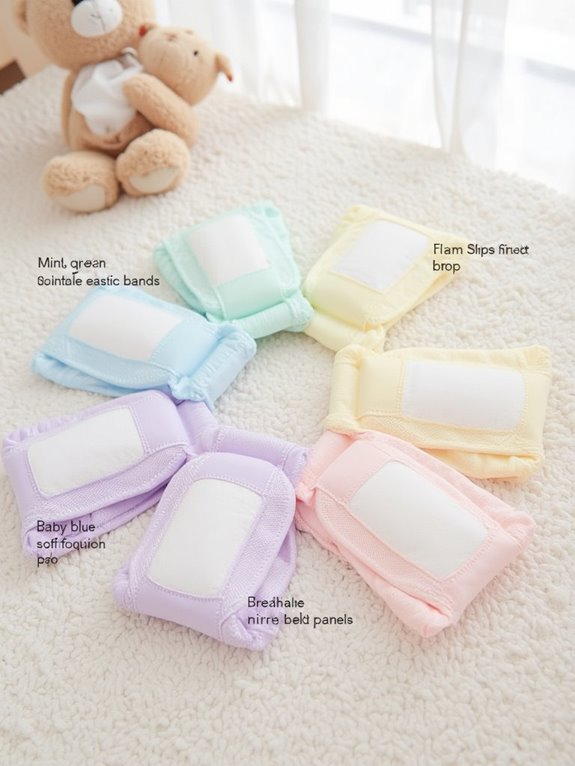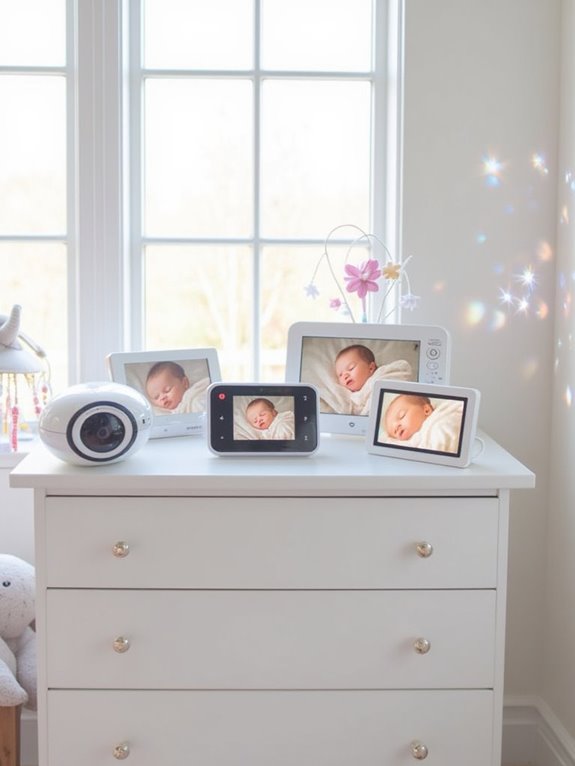Links below are affiliate links. We earn a commission on purchases at no extra cost to you. Although our opinions are based on curated research, we haven't used these products. Articles generated with AI.
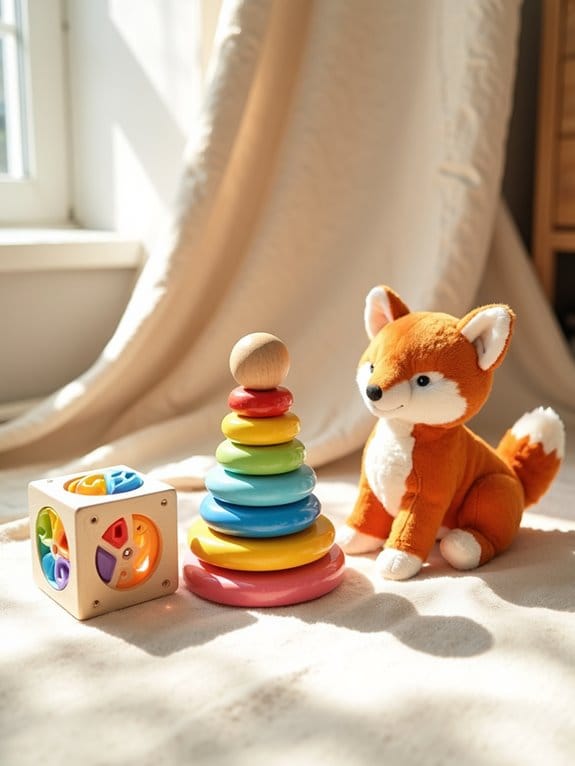
The 3 Best Baby Toys of 2025, According to Child Development Experts
Child development experts have identified 2025’s top three educational toys after rigorous safety and developmental testing. You’ll find the Talking Cactus Dancing Toy excels in language development with its mimicking function, while the Sassy Stacks of Circles (9-piece set) promotes early STEM skills through sorting and stacking. The Amazon Basics Soft Play Wall Climb and Slide supports physical development with its 160-pound weight capacity and non-toxic materials. Discover how these toys’ specific features support your child’s growth milestones.
Key Takeaways
- Expert-recommended toys increasingly focus on multi-sensory features combining lights, sounds, and textures for comprehensive developmental benefits.
- Safety certifications like CPSIA and CPC are paramount, with toys using non-toxic materials and incorporating anti-choking design elements.
- Interactive toys that record and mimic speech patterns are gaining popularity for supporting early language development.
- Modular designs that grow with children from 6 months to 6 years offer better long-term value and sustained engagement.
- Durability features, including reinforced seams and impact-resistant materials, ensure toys withstand regular use while maintaining safety standards.
Talking Cactus Dancing Toy with Mimicking Function
Sale
Hunfur Talking Cactus Toy That Talks Back,Volume Adjustment Dancing Mimicking Cactus Baby...
- UPGRADED VOLUME CONTROL BUTTON:The volume is adjustable compared to other cactus talk back toy. Too loud or too low volume will make you or your child uncomfortable,...
- EDUCATIONAL GIFT TOYS: Repeating, Recording, Mimicking, Speaking, Copying cactus toy can record and repeat what you said with its funny voice, encouraging the child to...
- LED COLORFUL FLASHING LIGHT:Singing cactus toy mimics sings including nursery rhymes and TikTok hits in turn. The cactus dancing toy will twist his body and have...
The Talking Cactus Dancing Toy with Mimicking Function stands out as an ideal choice for parents seeking a developmentally appropriate toy for children 6 months to 6 years old. This interactive toy combines essential safety features with engaging functionality.
You’ll find it’s built with non-toxic plush materials that meet CPSIA and CPC safety standards. The adjustable volume control prevents discomfort, while the stable plastic base ensures it won’t tip over. Its key features include:
- Speech recording and mimicking capabilities
- Dancing movements with LED light display
- Educational benefits for language development
- Easy-to-clean surface
- Gift-ready packaging in mesh bag
For safety concerns or technical support, contact customer service through the included information card.
Best For: Parents seeking an interactive, educational toy for children aged 6 months to 6 years who want to encourage language development and sensory engagement through music, movement, and light displays.
Pros:
- Multi-functional design combines speech mimicking, dancing, lights, and music for comprehensive entertainment and development
- Made with non-toxic materials and meets international safety standards, making it safe for young children
- Adjustable volume control and stable base design ensure comfortable and secure play experience
Cons:
- May require frequent battery changes due to multiple electronic functions
- Could become repetitive for older children who quickly master its features
- Surface cleaning limited to damp cloth only, which may not be sufficient for thorough sanitization
Sassy Stacks of Circles STEM Learning Toy (9 Piece Set)
Sassy Stacks of Circles Stacking Ring STEM Learning Toy, Age 6+ Months, Multi, 9 Piece Set
- Straight post accepts different sized rings, strengthening hand-eye coordination
- Chunky rings make it easy for baby to grasp, strengthening fine motor skills
- Each ring features a different texture and weight; Textural variety is great for mouthing.
Looking for a developmentally appropriate toy that’ll grow with your baby? The Sassy Stacks of Circles STEM Learning Toy offers 9 BPA-free plastic rings designed for infants 6 months and up. You’ll find each ring features unique textures, weights, and sensory elements like internal beads.
Key features:
- Center post accepts rings in any orientation
- Chunky, easy-grip design for small hands
- Varied textures stimulate tactile development
- Clear rings contain rattling beads
- Measures 4.25″ x 4.25″ x 8″
The toy ranks #1 in Amazon’s Stacking Toys category, with 4.8/5 stars from 61,000+ reviews. It’s thoroughly safety-tested and requires no batteries, making it a reliable choice for early STEM learning through stacking, sorting, and sensory exploration.
Best For: Parents seeking a safe, durable, and educational stacking toy for babies 6+ months that supports sensory development and early STEM learning concepts.
Pros:
- High-quality, BPA-free construction with varied textures and weights for enhanced sensory exploration
- Frustration-free design with rings that can be stacked in any orientation
- Versatile use as a stacking toy, teether, and sorting activity with excellent durability
Cons:
- Made in China, which may concern some parents
- Limited to 9 pieces, which might not be enough variety for older toddlers
- Size may be smaller than expected at only 8 inches tall when fully stacked
Amazon Basics Soft Play Wall Climb and Slide (6-Piece Set)
Amazon Basics Soft Play Wall Climb and Slide for Kids, Indoor Climbing Foam, Medium, 6-Piece (Red,...
- 6-piece indoor wall climb and slide for young toddlers and children; ideal for home, daycare center, or preschool
- Interlocking hook-and-loop strips secure the pieces together; hook-and-loop bottom helps keep it in place on carpet
- Helps kids learn gross motor skills and coordination
Parents seeking safe, durable climbing equipment for active toddlers will find the Amazon Basics Soft Play Wall Climb and Slide 6-piece set meets essential developmental needs. The set’s interlocking foam pieces support up to 160 pounds and feature anti-slip bottoms for stability on various surfaces.
Key safety features include:
- Hook-and-loop fasteners for secure assembly
- Easy-to-clean, durable foam covers
- Six colorful pieces measuring 60 x 40 x 10 inches total
The set promotes gross motor skills, balance, and coordination while providing a safe climbing alternative to furniture. You’ll appreciate its portability and storage flexibility. While some users note a slight initial foam odor, the set’s proven durability and developmental benefits make it a worthwhile investment for growing children.
Best For: Parents and caregivers seeking a safe, durable indoor climbing structure for toddlers and young children to develop motor skills and burn energy.
Pros:
- Versatile 6-piece set with secure interlocking design and anti-slip bottom for safety
- Supports up to 160 pounds and features easy-to-clean, durable foam construction
- Promotes physical development through climbing, sliding, and active play while providing a safer alternative to furniture
Cons:
- Initial foam odor may require airing out before first use
- Limited Velcro attachment points can restrict configuration options
- Anti-slip bottom may not perform optimally on smooth surfaces
Factors to Consider When Choosing Baby Toys
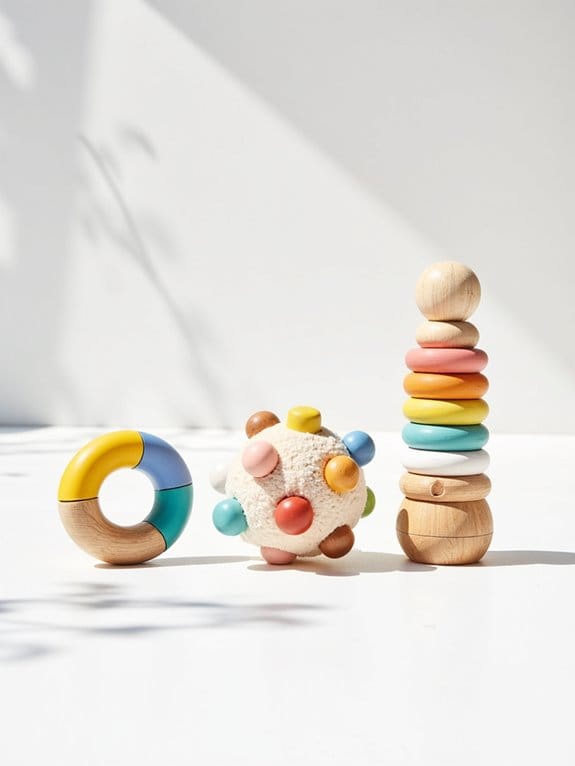
When you’re selecting toys for your baby in 2025, you’ll want to consider five key factors that directly impact your child’s development and safety. These essential elements include choosing age-appropriate toys that match developmental milestones, verifying safety certifications and high-quality materials, and ensuring the toy offers educational value through features like shape sorting or number recognition. Your decision should also account for the toy’s durability under regular use and its ability to engage multiple senses through varied textures, sounds, and visual elements that promote cognitive growth.
Age-Appropriate Development Stages
Selecting age-appropriate toys can substantially impact a child’s developmental journey through their early years. When you’re choosing toys, consider these key developmental stages:
0-6 months:
– Focus on soft, chewable toys that support your baby’s natural oral exploration
6-12 months:
- Select toys that encourage grasping and develop hand-eye coordination
- Include items demonstrating cause-and-effect relationships
1-2 years:
- Choose toys supporting walking abilities
- Incorporate stacking toys for motor skill development
- Add simple problem-solving activities
2-3 years:
- Provide toys promoting imaginative play
- Include sorting activities
- Select items supporting language development
3-6 years:
- Introduce more complex building sets
- Add role-play toys
- Include basic STEM-focused activities matching their growing cognitive abilities
Safety and Material Quality
Safety stands as the paramount consideration when choosing toys for babies and young children. When evaluating toy safety and material quality, you’ll need to focus on several critical factors.
First, guarantee all materials are non-toxic, BPA-free, and hypoallergenic to protect your baby’s health. Check for smooth surfaces without sharp edges or loose parts that could become choking hazards. The toy’s construction should feature reinforced seams and securely attached components to prevent detachment during play.
Look for safety certifications like CPSIA or CPC on product labels. These standards verify that manufacturers have met strict safety requirements. The materials should also demonstrate durability and tear resistance to withstand repeated use. When examining potential toys, run your fingers along all surfaces and test the strength of attached parts to confirm they’re firmly secured.
Educational Value
Educational value serves as a crucial factor in selecting developmental toys for your baby’s growth and learning. When choosing toys, you’ll want to focus on items that promote essential STEM skills through activities like sorting, stacking, and exploring different sizes.
Look for toys that offer:
- Interactive features promoting language development through recording, mimicking, and singing
- Multi-sensory stimulation with varied textures, colors, and sounds
- Age-appropriate learning opportunities that match your child’s developmental stage
- Combined entertainment and educational elements
The best educational toys will engage your baby while teaching fundamental concepts. Quality learning toys should provide clear developmental benefits while maintaining your child’s interest through play. Select items that grow with your child and offer multiple ways to learn through hands-on exploration and discovery.
Durability Under Use
When it comes to baby toys, durability stands as a fundamental consideration that directly impacts both safety and value. You’ll want to look for toys made from BPA-free plastics, soft foam, or non-toxic fabrics that can withstand your baby’s constant exploration through biting and chewing.
Key durability features to check:
- Reinforced seams and sturdy clasps that won’t come loose
- Impact-resistant materials that prevent cracking or breaking
- Easy-to-clean surfaces that won’t deteriorate with regular sanitizing
- Minimal small parts to reduce breakage risks
- Construction that allows for thorough cleaning
Remember to inspect your baby’s toys regularly for signs of wear, cracks, or loose components. Toys that are built to last won’t just save you money – they’ll also keep your little one safer during play.
Sensory Stimulation Features
Selecting toys with robust sensory features plays a vital role in your baby’s early development. When evaluating sensory elements, you’ll want to look for toys that incorporate multiple stimulating features:
- Varied textures (smooth, bumpy, ridged surfaces)
- High-contrast colors and patterns
- Built-in sounds or musical elements
- Safe LED lights with automatic shut-off
- Crinkly fabrics or materials
Today’s leading baby toys combine these elements strategically to support cognitive growth and motor skills. You’ll find that quality sensory toys help your baby develop hand-eye coordination through interactive play. They’re also designed to provide a calming effect when your little one feels overwhelmed. When shopping, look for age-appropriate sensory features that’ll grow with your child’s developmental stages and maintain their interest through different types of engagement.
Easy to Clean
Maintaining a clean and hygienic environment for your baby’s toys stands as a crucial safety priority. When selecting toys, you’ll want to focus on materials that make cleaning simple and effective.
Key cleaning features to look for:
- Non-porous materials like plastic or silicone that you can easily wipe down
- Smooth surfaces without deep crevices where bacteria can hide
- Machine-washable plush toys that withstand regular cleaning
- Removable parts and covers you can wash separately
- FDA-approved, non-toxic finishes that won’t degrade with cleaning
These features ensure you can maintain proper hygiene without compromising the toy’s integrity. Regular cleaning becomes straightforward when you choose toys specifically designed with sanitization in mind, helping you protect your baby from harmful bacteria and maintain a safe play environment.
Size and Storage
The ideal size and storage features of baby toys play a vital role in both safety and organization.
When selecting toys for your little one, you’ll want to focus on items that perfectly fit small hands for secure gripping. Look for toys that are compact enough to store easily but not so small that they become choking hazards. Stackable toys and those with multiple pieces should disassemble smoothly for efficient storage.
Consider these storage-smart features:
- Foldable or collapsible components
- Stackable designs
- Smooth edges for safe handling
- Interlocking pieces that fit together neatly
- Designated storage compartments
You’ll maximize play space and maintain an organized environment by choosing toys that combine appropriate sizing with smart storage solutions. This approach ensures both safety and functionality while preventing unnecessary clutter in your child’s play area.
Multi-Purpose Play Options
When investing in baby toys, multi-purpose options deliver exceptional value by combining different developmental activities into single, versatile items. You’ll get more from your purchase when selecting toys that serve multiple functions, like those offering both teething relief and musical elements.
Look for features that adapt as your child grows:
- Stacking components for motor skills
- Textured surfaces for sensory exploration
- Musical elements for auditory development
- Crawling motivation features
- Sorting activities for cognitive growth
These versatile designs not only support various developmental stages but also help you maintain a clutter-free space. Your child will discover new ways to interact with the same toy as they advance, enhancing their problem-solving abilities and creativity. Plus, you’ll appreciate having fewer items to organize and store.
Frequently Asked Questions
How Often Should Baby Toys Be Sanitized to Maintain Proper Hygiene?
You should sanitize your baby’s toys frequently based on usage patterns:
- Daily: Clean toys that contact your baby’s mouth or are used during meals
- Weekly: Sanitize all other frequently used toys
- Monthly: Disinfect toys used occasionally
Use a solution of 1 tablespoon bleach per gallon of water or sanitizing wipes specifically made for baby items. After cleaning, rinse thoroughly and air dry. For electronic toys, wipe with disinfectant cloths only. Don’t forget storage bins and containers.
What Age Is Too Old for These Specific Developmental Toys?
You’ll want to shift your child away from basic developmental toys around age 2-3, as they’ll need more complex playthings to match their growing abilities. Here’s a quick guide:
- Rattles and teething toys: Phase out by 12-18 months
- Simple stacking toys: Typically outgrown by 24 months
- Basic shape sorters: Usually mastered by 30 months
However, every child develops at their own pace, so watch for signs that they’re ready for more challenging toys.
Are These Toys Safe for Babies With Sensory Processing Disorders?
Every parent’s heart skips a beat wondering about their child’s unique sensory needs. You’ll want to check with your child’s occupational therapist before introducing new toys, as they can best evaluate specific sensory triggers. These toys are designed with safety in mind, featuring:
- Smooth, rounded edges
- Non-toxic materials
- Various textures for controlled exposure
- Adjustable sound levels
However, you’ll need to monitor your baby’s reactions and remove any toy that causes distress or overstimulation.
Do These Toys Require Batteries, and How Long Do They Typically Last?
You’ll find that two of these toys require 2 AA batteries each, while one is completely battery-free. For the battery-operated toys, you can expect:
- Standard alkaline batteries last 3-4 months with regular use
- Rechargeable batteries last 2-3 months per charge
- Auto-shutoff feature helps preserve battery life
The battery-free option uses mechanical components that’ll last for years with proper care. It’s recommended to check battery compartments monthly for any corrosion or damage.
What Materials Should Parents Avoid When Selecting Similar Alternative Toys?
“Better safe than sorry” holds especially true when selecting toys for your little one. You’ll want to avoid materials that could pose health risks:
- PVC (polyvinyl chloride) containing phthalates
- Toys with BPA (bisphenol A)
- Items containing lead paint or finishes
- Small magnets that can detach
- Flimsy plastic that can break into sharp pieces
- Toys with unfinished or splintering wood
- Materials treated with toxic flame retardants
When in doubt, you can research the manufacturer’s safety certifications.

